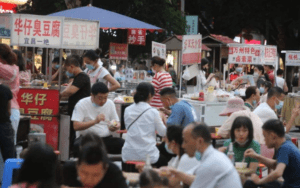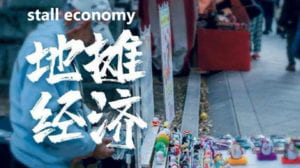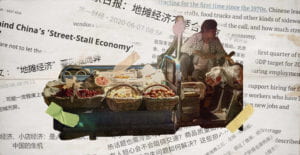Wenjun Fang(wf646)
Stall economy during the pandemic time in China
The stall economy has a long history in China. When I was young, there are lots of different kinds of food trucks around the campus. It is the most exciting thing for me to enjoy snack time with my friends after school. Besides food trucks, there are also street vendors selling comic books, funny little toys, or other interesting stuff for young school kids. Those street vendors are part of my generation’s communal childhood memory. However, street vending has then been controlled strictly by the government because the government believes they negatively influence the city’s appearance. The vendors always gathering together around the place where the flow of people is high, include campus, hospital, office buildings, and subway stations, which increased the risk of public safety. They do not have a fixed store, so it is hard to track all those vendors, making food safety issues or other commodity quality problems hard to solve. However, the stall economy has once again conquered the Chinese cities due to its unique economic ecology and strong vitality during the pandemic time.

A few months ago, the stall economy became the hottest topic on social media in China. At the end of this May, street vending has been officially removed from the state council’s city appearance assessment criteria. After being strictly managed for a long time, street vending has been allowed and encouraged by urban planners. The prime minister mentioned at the state council meeting that there are 600 million people in China with a monthly income of 1,000 RMB. Especially during the pandemic time, this large, low-income population losing jobs has become a serious social issue. Those people are usually at lower education levels, and most of them are manual workers. The decrease in lower threshold jobs on the market makes their life even harder. Therefore, street vending became the political expedient during the pandemic time.


Street vending has characteristics of low cost and high flexibility. When there was no job, street vending became the way to create more jobs, especially for low-income people. It doesn’t need high education level or particular skills, even does not need that much investment to start the business. It does not require street vendors to be creative or innovative; it is still a traditional business model. For long-term economic development, the stall economy is not a good idea since it will make the economic system lose its competitiveness and cause a bigger problem. But for the short term, such a low-cost way of starting a new business is an urgent solution to increase job opportunities.

On the other hand, social media also played an important role in encouraging street vending. I found it interesting that most people discussing the street vending and stall economy online are not the vendors but the customers. They are not coming from the low-income group, but their interests in street vending make the business happened. The street vending awakens their childhood memories, which makes them willing to shop at such places. It is also a critical reason why street vending can be so popular during the time.

Leave a Reply